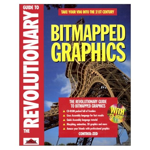The Revolutionary Guide to Bitmapped Graphics
December 29, 2009 This is another book from my library that I have decided to take a look back on and see if there are any useful tidbits to be used by programmers today. As with most technical books which are more than ten years old, there is usually an abundant amount of information about specific technologies which are no longer in popular use, or perhaps the technologies are still present in one form or another but the means to access them have changed dramatically. I personally believe that many of these books can give the novice programmer a background not taught in universities and colleges and will certainly give them an edge when working on limited or older machines.
This is another book from my library that I have decided to take a look back on and see if there are any useful tidbits to be used by programmers today. As with most technical books which are more than ten years old, there is usually an abundant amount of information about specific technologies which are no longer in popular use, or perhaps the technologies are still present in one form or another but the means to access them have changed dramatically. I personally believe that many of these books can give the novice programmer a background not taught in universities and colleges and will certainly give them an edge when working on limited or older machines.
The book does talk about video hardware used in that time period and delves deep into the programmatic underpinnings when accessing the display and creating custom video modes. I found some of the discussions to be noteworthy but if you really want a thorough explanation, you may want to investigate the Zen of Graphics Programming or the Graphics Programming Black Book. It also delves into a bit of assembly language primer, which is very typical for these books, since many of the routines were coded using that language. The introduction is short but may be a nice refresher for those who haven’t gotten their hands dirty in a couple of years.
I’ve made a list of what was still useful for work you may be doing today – unless you’re one of the lucky few who get to maintain software written in 1994. Your mileage will vary as some of the techniques are really just short introductions to a much larger field like digital image processing (DIP) and morphing. It even had a short introduction to 3D graphics, which seemed to be slapped on at the end because the publisher wanted “something on 3D” so they could put it on the cover.
- It provided color space introductions, conventions, and conversions for the following spaces: CIE, CMY, CMYK, HSV, HLS, YIQ, and RGB. Most of the conversions go both ways (to and from RGB space), although CMY/K conversion calculations are only provided from RGB space.
- Dithering and half-toning, followed by a chapter on printing. I think the authors mentioned Floyd-Steingberg in there somewhere, but it wasn’t a full discussion.
- Fading the YIQ and HLS color space. I’m not sure why they didn’t provide one for the RGB space, but it could very well be on the bundled CD-ROM.
- It introduces the reader to a few algorithms for primitive shape drawing and clipping, like Bresenham line drawing and Sutherland-Cohen clipping. It also included discussions and examples for ellipses, filled polygons, and b-spline curves.
- Extensive discussions on graphics file formats for GIF, JPEG, TGA, PCX, and DIB. Although these tended to be higher-level than what would have been useful for someone implementing a decoder for any one of these formats (with the possible except of PCX). Associated algorithms like LZW and RLE are also explained as they are used by encoders of these formats.
- The topic on fractals and chaotic systems was a little out of place, but was a little more extensive than the chapter on 3D. It did explain the concept of an L-system fractal, and even provided a generator for it. When supplied with a configuration file, it could produce fractals like the von Koch curve. It briefly touched on the Harter-Height Dragon fractal and introduced the Mandelbrot and Julia sets, but didn’t delve into chaos theory, even though I’m sure one the authors desperately wanted to do so.
- Related to the discussion of fractals was the section on generated landscapes via the midpoint displacement method. While not a landscape per se, the authors digressed a bit to talk about cloud generation as well.
The book finally managed to get around to the reason I bought it in the first place many years ago, which was the all too brief chapter on DIP techniques. It quickly introduced and provided code for algorithms like the Laplace filter, as well as popular effects like emboss, blur, diffuse, and interpolation. The treatment was very light, so the reader will not walk away with a solid understanding for any of the example code, other than trivial effects like pixelate or crystalize.
Categories: Books, Graphics, PC, Programming
3 Comments »







3 Responses to “The Revolutionary Guide to Bitmapped Graphics”
Did you manage to re-read the whole book? How long have you been at it? And were you neglecting your poor wife because of it? ;)
No, on both counts.
I was starting to work in Control Zed company with those guys who wrote this book. The image of a crater was my small contribution :)..
Care to comment?